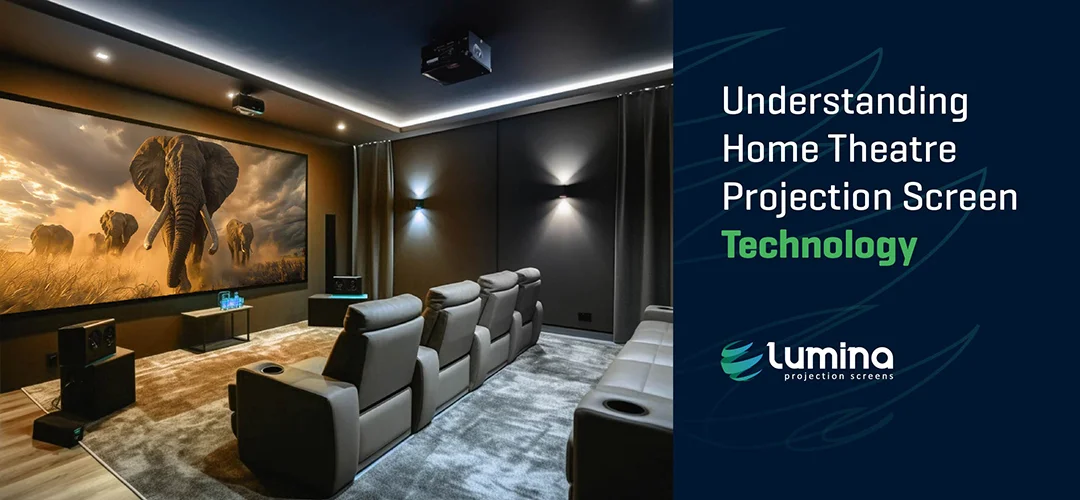
Home theatre projection screens play a crucial role in delivering high-quality visuals. They significantly impact the clarity, brightness, and overall viewing experience. This blog post aims to demystify projector screen technology, focusing on the key components and considerations necessary for choosing the right screen for your setup.
Screen Material and Composition
The material of a projection screen is fundamental to its performance. Different materials, such as matte white, grey, and Ambient Light Rejection (ALR), offer various benefits. Matte white screens are popular due to their accurate color reproduction and wide viewing angles. Grey screens enhance contrast in rooms with some ambient light. ALR screens are designed to reject ambient light, making them ideal for bright environments. Selecting the right material depends on the room’s lighting conditions and the desired image quality. For example, Lumina Screens Leor Black provides exceptional contrast and color accuracy as it rejects upto 90% of ambient light compared to a standard matte white screen.
Gain and Viewing Angle
Gain measures the reflectivity of a screen. Higher gain screens (above 1.0) increase image brightness, which is useful in low-light environments. However, higher gain often reduces the viewing angle, meaning the image quality drops off when viewed from the side. Conversely, lower gain screens (below 1.0) have wider viewing angles but lower brightness. Balancing gain and viewing angle is crucial for creating an optimal viewing experience. Lumina Screens offers various gain options, such as the Leor 1.2, ensuring bright and clear images from multiple angles.
Screen Size and Aspect Ratio
Choosing the right screen size and aspect ratio is vital for an immersive viewing experience. The screen size should match the room dimensions and the projector’s throw distance. Aspect ratios like 16:9 are standard for home theatres, providing a cinematic experience. Calculating the optimal screen dimensions involves considering the distance between the screen and the viewers, ensuring everyone has a clear view. Lumina Screens provides customizable options to fit any space, from small rooms to large home theatres.
Surface Tension and Tensioning Systems
Surface tension is essential for maintaining a flat and uniform screen surface. Tensioned screens use systems to keep the screen taut, preventing wrinkles and creases that can distort the image. This ensures consistent image quality across the entire screen. Lumina Screens tensioning systems are designed to provide a smooth, even surface, enhancing the overall viewing experience by eliminating imperfections.
Coating and Reflective Properties
The coating on a projection screen can significantly enhance image quality. Coatings improve color reproduction and brightness, offering a more vibrant and accurate picture. Different coatings are designed for specific projection applications. For instance, some coatings increase gain, while others enhance contrast. Understanding these properties helps you select a screen that best meets your needs. Lumina Screens uses advanced coatings to deliver exceptional image clarity and color fidelity.
Understanding the principles of projection screen technology helps in selecting the right screen for your home theatre.
Explore the range of options available from Lumina Screens to find the perfect screen for your needs. Achieve the perfect picture and elevate your viewing experience with the right projector screen.
FAQ’s
What types of projection screen technologies are used in home theaters?
Common technologies include Matte White, High-Gain, and Ambient Light Rejecting (ALR) screens, each offering different benefits for image quality and room conditions.
How does ambient light rejection (ALR) technology work?
ALR screens absorb ambient light and reflect the projector’s light, ensuring clearer, brighter images even in rooms with light exposure.
What is the advantage of a high-gain screen?
High-gain screens enhance brightness, making them perfect for rooms with ambient light, delivering sharper and more vibrant images.
What should I consider when choosing a screen material for home theater?
Screen material affects the image quality. For darker rooms, a matte white screen is ideal, while for well-lit rooms, ALR or high-gain materials work best.
Can Lumina Screens improve my home theater experience?
Yes, Lumina Screens use advanced technologies to deliver superior image clarity, brightness, and color accuracy, enhancing your home theater viewing experience.
- Date - June 25, 2024